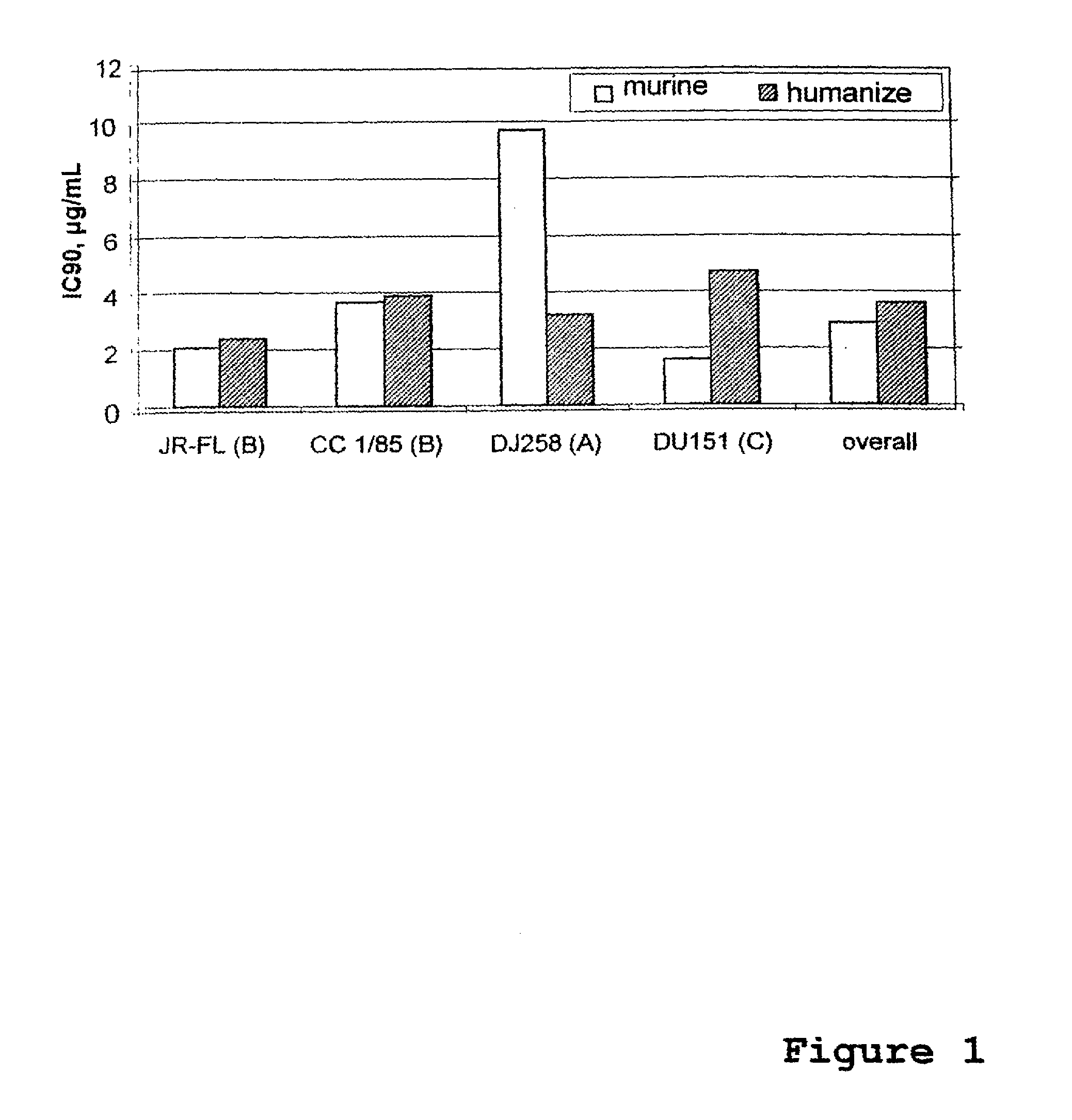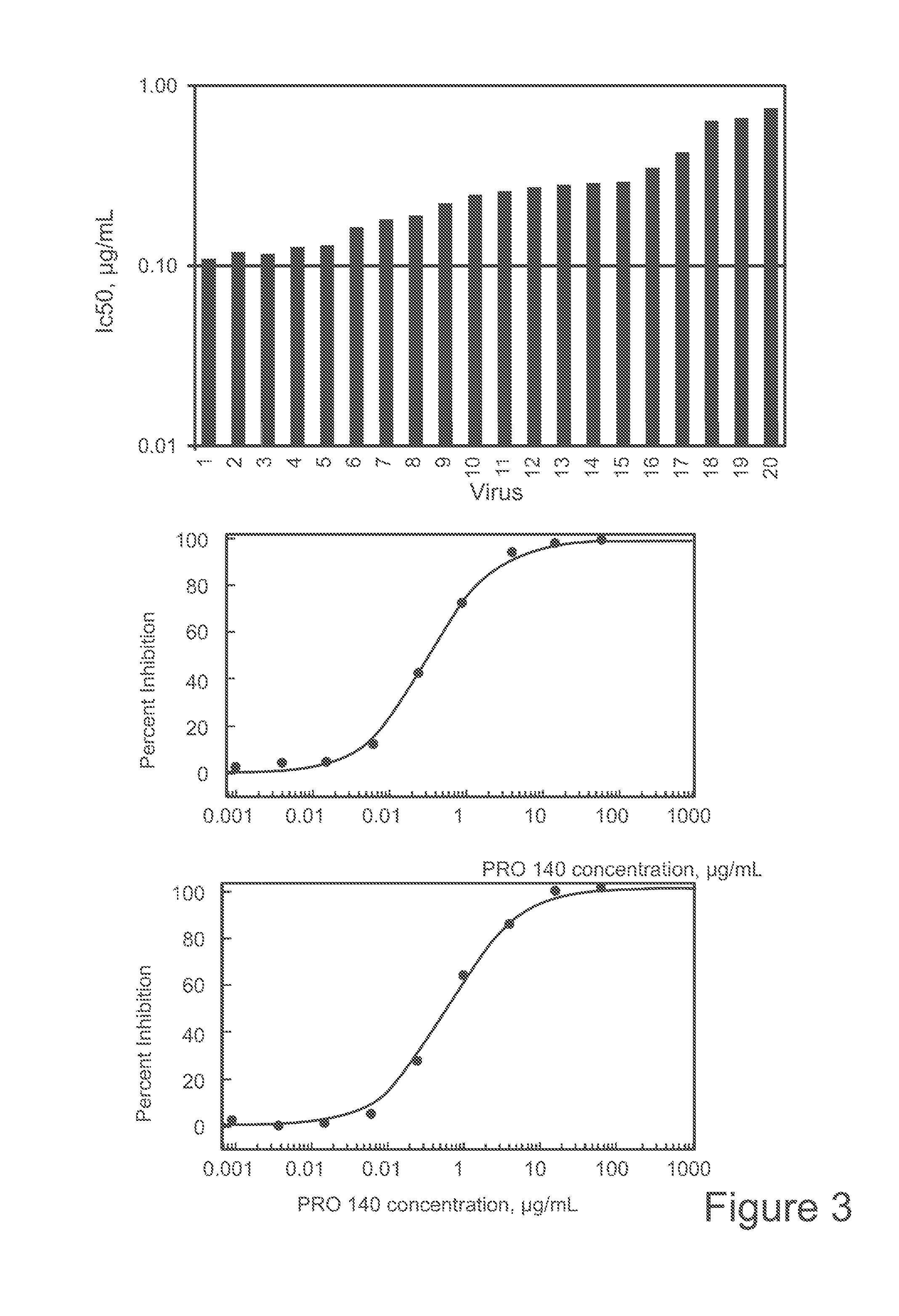Use of Anti-ccr5 antibodies in graft versus host disease
an anti-ccr5 antibody and graft technology, applied in the direction of antibody medical ingredients, drug compositions, peptides, etc., can solve the problems of reducing the effectiveness of orally ingested therapeutics, affecting the treatment effect of graft versus host disease, and inconvenient intravenous dose, so as to prevent, treat, or mitigate the effects of gvhd
- Summary
- Abstract
- Description
- Claims
- Application Information
AI Technical Summary
Benefits of technology
Problems solved by technology
Method used
Image
Examples
example 1
Combination Testing of Pro 140 and HIV-1 Entry Inhibitors in the Fluorescence RET Assay
Materials and Methods
[0180]Compounds and mAbs
[0181]PRO 140 was prepared by expression in Sp2 / 0 cells using Hybridoma serum-free medium supplemented with 2 mM L-glutamine (Invitrogen, Carlsbad, Calif). Bulk mAb was clarified using a 5.0 .mu.m Depth filter (Sartorius, Goettingen, Germany) followed by passage over a 0.2 .mu.m sterilizing grade filter (Sartorius). The mAb was purified by passage first over an affinity column (MabSelect Protein A column, Amersham, Piscataway, N.J.) and then by ion exchange chromatography (SP Sepharose Cation Exchange resin, Amersham). PRO 140 was nanofiltered using a Viresolve™ 10 Opticap NFP capsule (Millipore, Billerica, Mass.) followed by a 0.2 .mu.m filter- and concentrated / diafiltered over disposable TFF cartridges (Millipore). The mAb was then polished over a hydroxyapatite column (Bio-Rad, Hercules, Calif.), concentrated to 10 mg / ml in phosphate-buffered saline ...
example 2
Combination Testing of Pro 140 with Small Molecule, Peptide and Protein Inhibitors, and HIV-1 in the HIV-1 Pseudovirus Particle (HIV-1PP) Assay
Materials and Methods
Preparation of HIV-1 Pseudoparticles
[0219]HIV-1 pseudoparticles (HIV-1pp) are generated in 293T cells by transient coexpression of an HEV-1-based NL4 / 3luc+env-plasmid and a construct encoding HIV-1.sub.JRFL Env. The NL4 / 3luc+env-plasmid was obtained from the NTH AIDS Research and Reference Reagent Program (Cat No. 3418), and the HIV-1.sub.JRFL Env was inserted into the pcDNA3.1 vector (Invitrogen). Briefly, 293T cells are calcium phosphate transfected with a 1:1 ratio of NL4 / 3luc+env-reporter vector and Env expression vector in Hepes buffer (Protection Mammalian Transfection Kit, Promega). After 16 h the transfection medium is aspirated and fresh cell culture medium (DMEM with 10% FBS, glutamine and antibiotics) is added and the incubation is continued at 37.degree.C. for an additional 24-32 h. Cell culture supernatants a...
example 3
Combination Testing of Pro 140 with Small Molecule, Peptide and Protein Inhibitors in the HIV-1 Authentic Virus Replication Assay
Materials and Methods
Preparation of PBMCs
[0228]Replication of authentic HIV-1 is measured in activated peripheral blood mononuclear cells (PBMCs) using the monocyte / macrophage-tropic HIV-1 clone, JRFL (HIV-1.sub.JRFL), for these studies. PBMCs are isolated from 4 separate donors (Leukopacks) by centrifugation on a Ficoll gradient, CD8 cells are depleted using RosetteSep CDS Depletion Cocktail (#15663, StemCell Research, Vancouver, BC). Cells are diluted to 4.times.10.sup.6 / ml and added in equal parts to three T! 75-cm.sup.2 flasks and then stimulated by addition of one of the following media: IL-2 Medium [RPMI1640 (#10-040-CV, Cellgro, Herndon, Va.), 10% FBS (#35-010-CV), 2 mM L-Glutamine (#25-005-CI), 100 U / mi IL-2 (Sigma, St. Louis, Mo.)]; PHA 5 Medium: [IL-2 Medium with 5 ug / ml Phytohemagglutinin PHA-P (PHA) (# L8754, Sigma, St. Louis, Mo.), filtered]; ...
PUM
| Property | Measurement | Unit |
|---|---|---|
| molar ratio | aaaaa | aaaaa |
| molecular weight | aaaaa | aaaaa |
| molecular weight | aaaaa | aaaaa |
Abstract
Description
Claims
Application Information
 Login to View More
Login to View More - R&D
- Intellectual Property
- Life Sciences
- Materials
- Tech Scout
- Unparalleled Data Quality
- Higher Quality Content
- 60% Fewer Hallucinations
Browse by: Latest US Patents, China's latest patents, Technical Efficacy Thesaurus, Application Domain, Technology Topic, Popular Technical Reports.
© 2025 PatSnap. All rights reserved.Legal|Privacy policy|Modern Slavery Act Transparency Statement|Sitemap|About US| Contact US: help@patsnap.com



